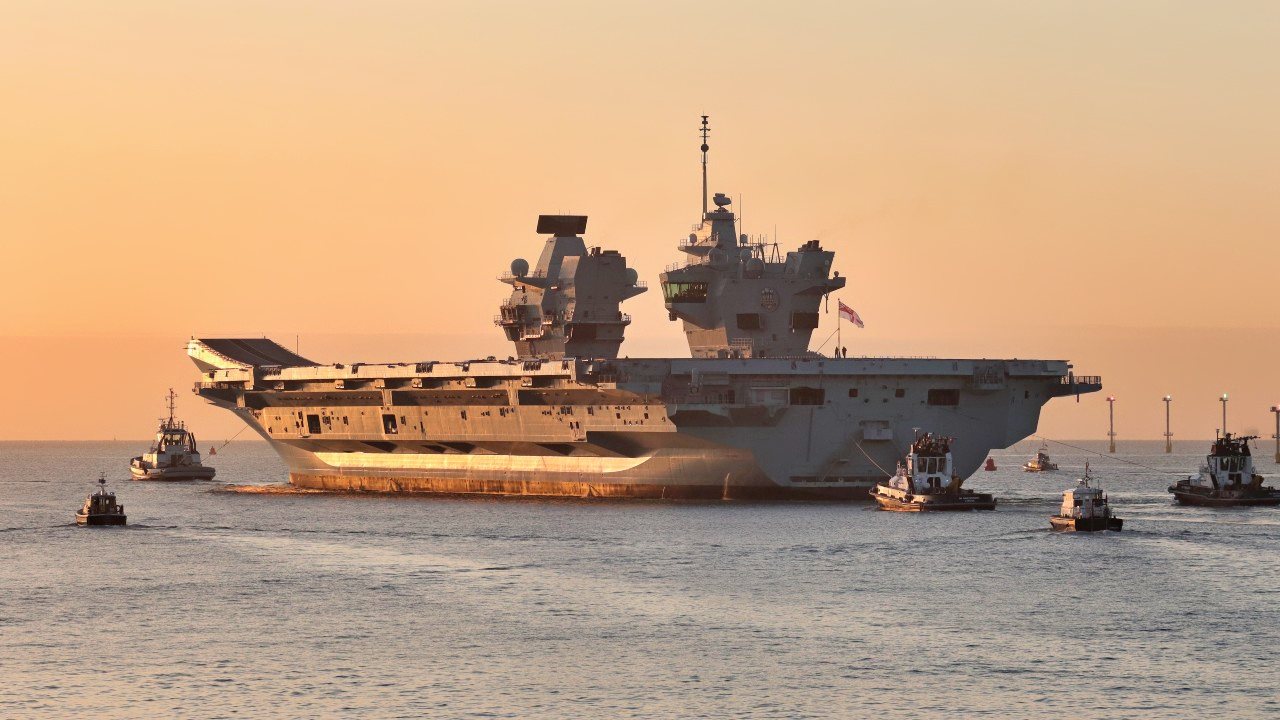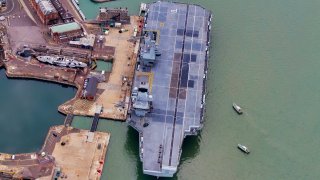Sending A Royal Navy Aircraft Carrier to Take on the Houthis Might Be a Mistake
At present, the sending of HMS Queen Elizabeth or her sister ship HMS Prince of Wales hasn't been made official. But already, some are warning that such a deployment could be a mistake.
Is the Royal Navy's Aircraft Carrier Up to Confronting the Houthis in Yemen?: Rumors circulated this week that it Royal Navy could deploy one of its two conventionally-powered aircraft carriers to the Red Sea or the Gulf of Aden to replace the United States Navy's Nimitz-class nuclear-powered USS Dwight D. Eisenhower (CVN-69), which began her current deployment last October.
At present, the sending of HMS Queen Elizabeth or her sister ship HMS Prince of Wales hasn't been made official. But already some are warning that such a deployment could be a mistake.
HMS Queen Elizabeth operates with a much smaller airwing than the U.S. Navy's carrier. While the Royal Navy's flagship has the Lockheed Martin F-35B Lightning II onboard, it has never operated with more than eight on board.
By contrast CVN-69's Carrier Air Wing (CVW) 3 consists of the "Gunslingers" of Strike Fighter Squadron (VFA) 105, the "Fighting Swordsmen" of Strike Fighter Squadron (VFA) 32, the "Rampagers" of Strike Fighter Squadron (VFA) 83, the "Wildcats" of Strike Fighter Squadron (VFA) 131, the "Screwtops" of Carrier Airborne Early Warning Squadron (VAW) 123, the "Zappers" of Electronic Attack Squadron (VAQ) 130, the "Dusty Dogs" of Helicopter Sea Combat Squadron (HSC) 7, the "Swamp Foxes" of Helicopter Maritime Strike Squadron (HSM) 74 and the "Rawhides" of Fleet Logistics Support Squadron (VRC) 40.
Simply put: that is a lot more airpower – a point noted by Tom Sharpe of the UK's Telegraph newspaper, who offered this commentary:
"Our carriers are a great capability but even when they are fully formed, in some faraway time when we have a full complement of UK jets and other aircraft to put on them, they will never rival a US Carrier Strike Group for the breadth of capability and firepower. This doesn't mean they aren’t capable but they aren't as capable as that."
Sharpe further suggested that the Royal Navy's carriers are nowhere near being fully formed and equipped, and suggested there are gaping holes in the ships' airborne early warning, air-to-air refueling, and solid stores support – which includes food, jet parts and ammunition and other goods.
"The point is, with the Eisenhower group in place, all of these shortcomings can be mitigated. Take Ike away and things look a bit thin," Sharpe warned.
A Carrier Strike Group
A point Sharpe didn't note, however, is what vessels might support HMS Queen Elizabeth or HMS Prince of Wales. The IKE Strike Group is made up of the nuclear-powered carrier but also the guided-missile cruiser USS Philippine Sea (CG 58), and guided-missile destroyers USS Mason (DDG 87) and USS Gravely (DDG 107) of Destroyer Squadron (DESRON) 22.

Those vessels can provide a lot of firepower to protect the flattop.
Thus the Royal Navy can't commit to just sending an aircraft carrier – it will need to send a carrier strike group that can ensure its floating airbase is protected. Otherwise, it will just offer the Houthi rebels a large target to try to sink.
Author Experience and Expertise: Peter Suciu
Peter Suciu is a Michigan-based writer. He has contributed to more than four dozen magazines, newspapers, and websites with over 3,200 published pieces over a twenty-year career in journalism. He regularly writes about military hardware, firearms history, cybersecurity, politics, and international affairs. Peter is also a Contributing Writer for Forbes and Clearance Jobs. You can follow him on Twitter: @PeterSuciu. You can email the author: [email protected].
Image Credit: Shutterstock.


